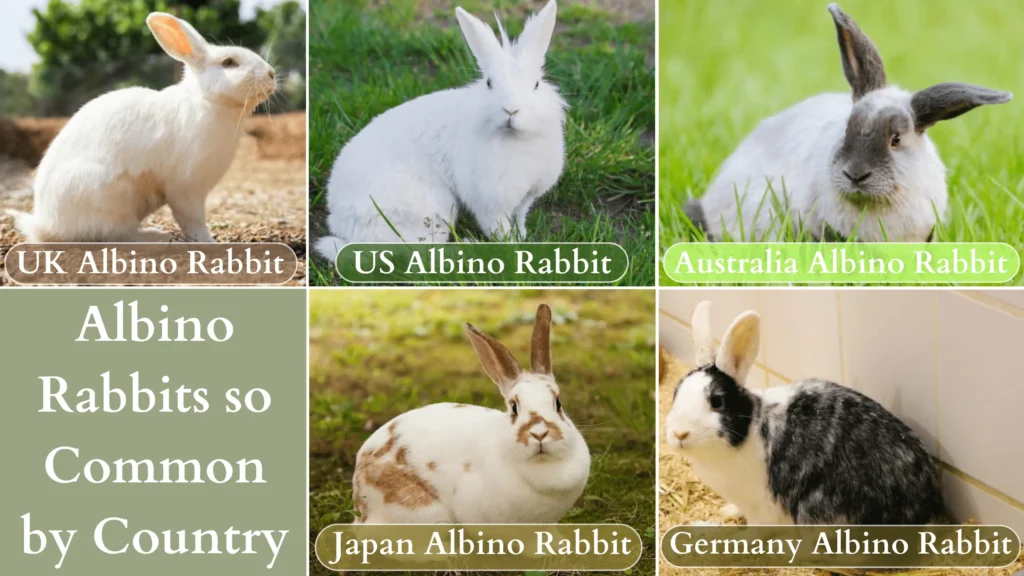Have you ever wondered why are albino rabbits so common? Although they are easily recognized by their pure white fur and red eyes the reasons for the abundance of albino rabbits are fascinating and complex. Albino rabbits are characterized by their lack of melanin which has attracted the attention of pet owners, breeders, and researchers. This unique characteristic is due to mutations in genes that affect pigment production resulting in the iconic appearance of albino rabbits.
In our country, the incidence of albino rabbits is due to selective breeding. The striking appearance of albino rabbits has made them very popular in the pet trade and at rabbit shows so breeders pay special attention to obtaining these visually appealing animals. In addition, due to their stable and predictable genetic traits albino rabbits are often used in scientific research further increasing their prevalence.
In contrast, albino rabbits are relatively rare in the wild due to natural selection pressure. Their bright white fur is easily spotted by predators and their lack of melanin can cause vision problems. Despite these problems the prevalence of albino rabbits among domestic rabbits and in research environments emphasizes the impact of human intervention and genetic interests on rabbit populations.
Explore the genetic and cultural reasons for the occurrence of albino rabbits and discover why these unique animals have such an important place in our lives.
- Understanding Albinism in Bunny:
- The Albino Rabbits so Common by Country:
- Top Rating of Albino Rabbit by Country:
- Fur and Eyes Color of Albino Rabbit:
- The Role of Selective Breeding:
- Evolutionary and Ecological Considerations:
- The Cultural and Symbolic Significance of Albino Rabbits:
- Ethical Considerations in Breeding Albino Rabbits:
- Conclusion:
- Frequently Asked Question:

Understanding Albinism in Bunny:
Albinism is an inherited disease caused by mutations in one or more of the genes responsible for the production of melanin (the pigment of the skin, fur and eyes). In rabbits albinism is caused by a recessive allele which means that rabbits must inherit two copies of the albino gene (one from each parent) in order to develop the albino phenotype. Due to the lack of melanin rabbits have white fur and unpigmented pink or red eyes with visible blood vessels.
Genetic basis of Albinism in Rabbits:
The primary albino gene responsible for albinism in rabbits is the tyrosinase (TYR) gene and mutations in the TYR gene inhibit the enzyme’s ability to catalyze melanin production. If a rabbit inherits two copies of the mutated TYR gene it becomes albino. This recessive mode of inheritance means that unless both parents carry at least one albino allele the offspring cannot be albino rabbits.
Albino allele frequency domestic Rabbit:
The frequency of albino alleles in a rabbit population has a significant impact on the number of albino rabbits. In wild rabbit populations the frequency of albino alleles is relatively low due to natural culling pressures. However, in domestic rabbit populations, albino alleles are more common due to selective breeding.
Prevalence of Albino Rabbits:
As a result of natural selection albinism is relatively rare in wild rabbit populations. Albino rabbits are more likely to be spotted by predators and a lack of melanin in the eyes can affect vision making survival more difficult. However, in domestic rabbit populations albino traits are more common due to selective breeding.
Selective breeding of Albino:
Humans have selectively bred rabbits for different traits such as coat colour, body size and temperament. The unique appearance of albino rabbits makes them ideal for the pet trade and research. Breeders usually select albino rabbits to meet their own needs thus increasing the prevalence of albino rabbit alleles in domestic populations. Albino rabbits are also often used in scientific research because their genetic structure is stable and predictable further increasing their popularity.
Show Rabbits:
Albino rabbits are popular at rabbit shows because of their unique appearance. In order to obtain quality rabbits breeders may prefer albino rabbits which further increases the prevalence of this trait in some breeding programmer.
The Albino Rabbits so Common by Country:
The albino rabbit which is characterized by its white fur and pink or red eyes has been of interest to people around the world for centuries. Its history varies from country to country and has been influenced by cultural scientific and economic factors. This article looks at the history of albino rabbits in different countries and highlights how they have been perceived, kept and used in different environments.

United Kingdom:
- Early breeding and domestic use:
The history of albino rabbits in the UK is closely linked to the development of domestic rabbit breeds. In the 19th century, rabbit breeding became a popular hobby resulting in many rabbit breeds including those characterized by albino characteristics. Albino rabbits are known for their striking appearance and are often exhibited at rabbit shows. The establishment of rabbit clubs and breeders’ associations has facilitated the breeding and exhibition of albino rabbits.
- Scientific research:
Albino rabbits also play an important role in scientific research in the UK. Because they lack pigmentation albino rabbits are ideal for genetic, ophthalmology and dermatology research. Scientists appreciate the predictable genetic structure and consistent appearance of albino rabbits, making them indispensable equipment in the laboratory.
United States:
- Pet trade and popularity:
Albino rabbits became popular pets in the United States in the middle of the 20th century. Their unique appearance and gentle temperament made them sought-after companions. Breeders capitalized on this demand and increased the breeding of albino rabbits for the pet trade. Albino rabbits are also popular in 4-H clubs and county fairs where they are often exhibited and judged in competitions.
- Role in research:
As in the United Kingdom, albino rabbits are also used extensively in scientific research in the United States. The consistency of the albino trait makes these rabbits invaluable for a wide range of medical and genetic research. Institutions such as universities and pharmaceutical companies frequently use albino rabbits in their research programs.
Japan:
- Cultural significance:
In Japan, albino rabbits have cultural and symbolic significance. They are often associated with purity and innocence and their white fur is considered a symbol of good luck. Albino rabbits are often featured in Japanese folklore and art adding to their cultural significance. The Japanese white rabbit breed which often exhibits albinism and is a testament to the cultural significance of these animals.
- Breeding and caring for pets:
Albino rabbits are also popular pets in Japan. The country’s fascination with unique and exotic animals has contributed to the demand for albino rabbits. Breeders in Japan have focused on breeding albino rabbits with special characteristics to satisfy pet owners and enthusiasts.
Germany:
- Rabbit breeding and shows:
Rabbit breeding in Germany has a long history. Germany is well known for its organized rabbit breeders’ clubs and associations which promote the breeding of various breeds of rabbits including those with albino breeds. Albino rabbits often participate in rabbit shows where they are judged on appearance and conformity to breed standards.
- Contribution to research:
German researchers also use albino rabbits in scientific research. In Germany, where research and studies are strong albino rabbits are used in various fields including genetics, medicine and pharmacy.
Australia:
- Introduction and breeding:
Albino rabbits were introduced to Australia by European settlers in the 19th century. Originally imported for their meat and fur rabbits quickly became popular pets. Their albino nature and unique appearance appealed to many pet owners and breeders. Over time, albino rabbits became widespread in domestic rabbit populations.
- Environmental impact:
However, the introduction of rabbits into Australia has had a significant impact on the environment. Rabbits including albino breeds are multiplying rapidly and becoming an invasive species causing significant damage to local ecosystems. Rabbit populations are therefore controlled through various means including biological control measures.
Top Rating of Albino Rabbit by Country:
The popularity and reputation of albino rabbits varies widely from country to country depending on cultural preferences breeding habits and demand in the pet and show animal markets. Below is a brief overview of the evaluation and perception of albino rabbits in different countries:
| Country | Rating/Popularity |
| United States | High: Albino rabbits are popular as pets and in American rabbit shows. Their distinctive appearance makes them popular with pet owners and breeders. |
| United Kingdom | High: Albino rabbits are very popular in the UK especially at rabbit shows and among hobbyists. Their unique appearance contributes to their popularity in pet shops and among breeders. |
| Canada | Moderate to High: Albino rabbits are quite popular in Canada and are of great interest to pet owners and breeders. They are also highly regarded by those involved in rabbit shows and research. |
| Australia | Moderate: Albino rabbits are well known in Australia but they are not as common as in the United States or the United Kingdom. They are seen at animal markets and shows although interest may be more local. |
| Germany | Moderate: Albino rabbits are appreciated and recognized in Germany especially in breeding and showing. Their popularity is growing but not as much as in some English-speaking countries. |
| France | Moderate: In France, albino rabbits are prized among pet lovers and at exhibitions. Their unique appearance is appreciated although they may not be as visible as in some other European countries. |
| Japan | Moderate: Albino rabbits are recognized in Japan where they occupy a niche in the pet and show rabbit market. Their classification is medium with an emphasis on their distinctive appearance in the home and show environment. |
| China | Emerging: There is growing interest in albino rabbits in China especially in urban areas where exotic pets are becoming increasingly popular. Their appreciation continues to evolve as awareness and demand increases. |
Fur and Eyes Color of Albino Rabbit:
Below is a table summarizing the main aspects of coat and eye color in albino rabbits:

| Aspect | Description |
| Fur Color | Albino rabbits have a pure white coat due to the lack of the pigment melanin. The result is a uniform white coat that does not exhibit the color variations common in other rabbits. |
| Eye Color | Albino rabbits have red or pink eyes. This eye color is a direct result of a lack of melanin which causes the eyes to have a darker color due to the reflection of blood vessels when there is no pigment in the iris. |
| Skin Color | They also have pale or white skin because they lack the pigment melanin making their skin more sensitive to sunlight and more susceptible to sunburn. |
| Pigment Production | A mutation in the tyrosinase (TYR) gene prevents albino rabbits from producing melanin which determines the colour of their fur, skin and eyes. |
| Visual Implications | A lack of melanin in the eyes can lead to increased sensitivity to light and vision problems as the eyes are more exposed to light without a protective pigment. |
The Role of Selective Breeding:
Humans have played an important role in the spread of albino rabbits through selective breeding. For centuries rabbits have been bred for a variety of traits including coat color, size, temperament, and breeding ability. The unique appearance of the albino rabbit has become sought after in the pet trade, research, and rabbit show collections.
The Albino hare in the pet industry:
Albino rabbits are popular pets because of their striking appearance and gentle disposition. Breeders often choose albino rabbits to fill the demand for these special rabbits. As a result the frequency of albino rabbits in the domestic rabbit population is increasing. Albino characteristics are often accompanied by other desirable traits such as docility and lightness making albino rabbits particularly attractive to pet owners.
Albino Rabbits in research:
Albino rabbits are often used in research. Their lack of pigmentation makes them valuable for research in genetics, ophthalmology, and dermatology. For researchers albino rabbits provide a consistent and predictable model that facilitates the study of various diseases and treatments. The high demand for albino mice in research contributes to their proliferation in certain populations.
Show Rabbits and breeding programs:
Albino rabbits are often favored in rabbit shows because of their unique appearance. Breeders may favor albino traits in their breeding programs to produce rabbits suitable for shows. The competitive nature of rabbit show competitions encourages the selection of certain traits including albinos so albino rabbits are more likely to be found in these specialized breeding programs.
Evolutionary and Ecological Considerations:
Although human intervention has had a significant impact on the spread of albino rabbits in domestic populations. However, it is also important to consider evolutionary and ecological factors in wild populations.
Natural selection and Albino Rabbits:
Albino rabbits face significant challenges in surviving in the wild. Their white fur makes them highly visible to predators and reduces their chances of survival. The lack of melanin in their eyes can also cause visual impairment, making it difficult to detect predators and find food. As a result natural selection favors rabbits with normal pigmentation which leads to a decrease in the prevalence of the albino allele in wild populations.
Genetic drift and population bottlenecks:
Despite the shortcomings of selection albino rabbits can still occur in natural populations due to genetic drift and population bottlenecks. Genetic drift is the random variation in allele frequencies in a population that can lead to rare traits such as albinism. Population bottlenecks, when a significant portion of the population dies off can increase the frequency of certain alleles including albino alleles if the surviving individuals carry these genes.
The Cultural and Symbolic Significance of Albino Rabbits:
In addition to the genetic and ecological aspects albino rabbits have cultural and symbolic significance in different societies. Their unique appearance has inspired myths and artistic images throughout history.
Albino rabbits in folklore and mythology:
In some cultures, albino animals including rabbits, are considered special or magical. They can be associated with purity, innocence and otherworldly qualities. In folklore, albino rabbits are described as wise and mysterious creatures that play an important role in stories and myths.
Albino rabbits in art and literature:
The striking appearance of albino rabbits has also made them popular subjects in art and literature. Artists and writers often use albino rabbits as symbols of innocence, vulnerability and beauty. Their unique appearance is striking and adds depth to creative works.
Ethical Considerations in Breeding Albino Rabbits:
Although albino rabbits are prized for a number of reasons but ethical considerations arise when it comes to their breeding and care. The focus on producing albino rabbits can lead to health and welfare problems that need to be considered by breeders and owners.
Health problems in Albino Rabbits:
Albino rabbits can be prone to some health problems due to their lack of melanin. Their skin may be more sensitive to sunlight, increasing the risk of sunburn and skin cancer. Their eyes may also be more susceptible to light sensitivity and vision problems. Responsible breeders and owners must take these factors into account to ensure the well-being of albino rabbits.
Responsible breeding practices:
Responsible breeding practices are essential to minimize health and welfare problems. Breeders should prioritize the general health and genetic diversity of rabbit populations so than focusing solely on the albino trait. Proper husbandry including protection from excessive sunlight and regular veterinary examinations is essential to maintaining the health of albino rabbits.
Read More: https://thepetlive.com/albino-rabbits-cost/
Conclusion:
A combination of genetic, cultural and practical factors make albino rabbits particularly common. The genetic mutation responsible for albinism which affects melanin production and is making albino rabbits a surprising and unique variant in the rabbit population. Selective breeding has increased their prevalence in the domestic environment due to their characteristic white coat and red or pink eyes which are attractive to pet owners and show enthusiasts.
In addition, albino rabbits have contributed to their community in scientific research. Despite being rare in the wild due to the pressures of natural selection human breeding and research has ensured that albino rabbits are still familiar and popular in homes and laboratories.
Frequently Asked Question:
How common are albino rabbits?
Thanks to selective breeding albino chickens are relatively common in the livestock industry. Their distinctive white coat and red or pink eyes make them popular as pets and in research but they are less common in the wild.
What does my albino see?
Albino rabbits may have problems with vision and sensitivity to light because their eyes have no pigment.
How long do albino rabbits live as pets?
Albino rabbits typically live 7-10 years as pets when well cared for and provided with a healthy environment.
What is the rarest rabbit colour?
The rarest rabbit color is often considered “American Blue” or “Silver Fox” due to their unique and rare coloration.
What do albino rabbits eat?
Albino rabbits have the same diet as other rabbits a mixture of good quality straw, fresh vegetables and a small amount of pellets.
How long will my albino rabbit stay pregnant?
The gestation period for albino rabbits is about 30-32 days similar to other rabbit breeds.
How do rabbits react to humans?
Rabbits recognize people using visual and auditory cues and often respond to familiar sounds and movements.










